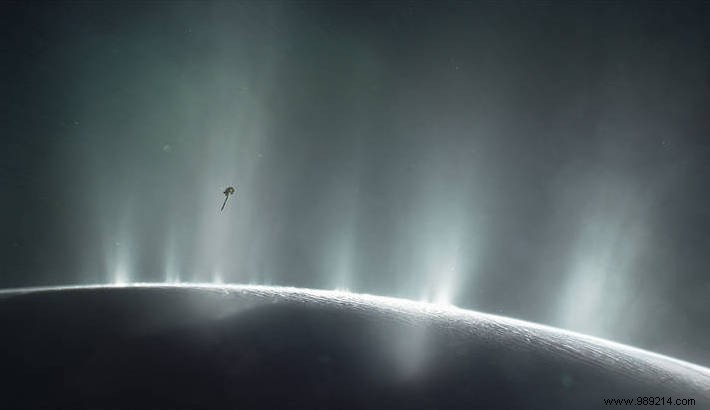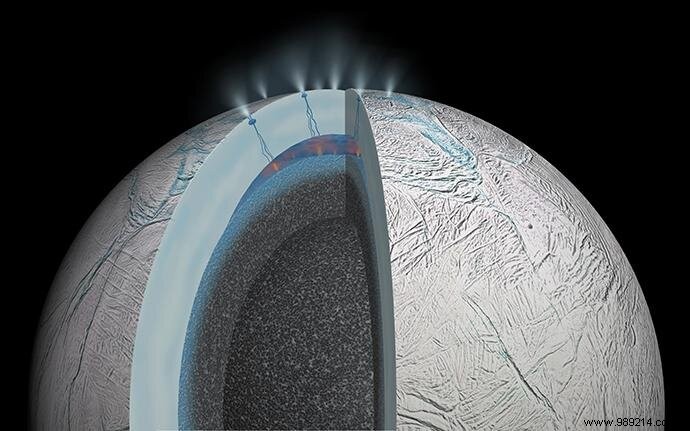A recent study published in Nature Astronomy suggests that the methane concentrations measured by Cassini in the plumes of Enceladus could have a biological origin. This methane production could also be the result of non-biological geochemical processes unknown on Earth.
Enceladus, one of Saturn's many moons, is just a small ball of ice 500 kilometers in diameter. Despite its small size, the object remains one of the most favored targets in exobiology. And for good reason, we know thanks to the American Cassini probe that jets of steam emanate from its depths, suggesting the presence of a global ocean sandwiched between its rocky core and its icy shell.
By flying over and sampling these plumes, Cassini also detected certain molecules associated with terrestrial hydrothermal vents, in particular dihydrogen, methane and carbon dioxide. Particularly unexpected was the amount of methane.
On Earth, hydrothermal activity occurs when cold seawater seeps beneath the ocean floor and passes near a heat source, such as a chamber of magma. The heated water is then spit out through hydrothermal vents.
We know that this hydrothermal activity can then produce methane through microorganisms (archaea) that metabolize molecular hydrogen and carbon dioxide (methanogenesis).
In a recent study, Regis Ferriere and his team at the University of Arizona wondered if Earth-like microbes known to consume dihydrogen and produce methane as a by-product (biological methanogenesis), could explain the surprisingly large amount of methane detected by Cassini.

Of course, testing this hypothesis in the field is currently impossible. For this work, the researchers therefore relied on mathematical models to calculate the probability that different processes, including biological methanogenesis, could explain the Cassini data.
For this work, the researchers evaluated which hydrothermal production of dihydrogen would best correspond to Cassini's observations. They then investigated whether this production could provide enough "food" to sustain a population of Earth-like methanogenic microorganisms, and whether a given set of chemical conditions (dihydrogen concentration, temperatures, etc.) could provide a suitable environment for the growth of these microbes.
Finally, the researchers examined what effects such a microbial population could have on its environment, particularly on methane leak rates in plumes.
According to these models, even the highest possible estimate of abiotic methane production – without biological aid – based on known hydrothermal chemistry is far from sufficient. to explain the concentration of methane measured in the plumes by Cassini. Adding biological methanogenesis to the equation, on the other hand, could produce the amounts of methane measured by the probe.
“We do not conclude that life exists in the ocean of Enceladus” , immediately warns Régis Ferriere “We just wanted to understand how likely it would be that the hydrothermal vents of Enceladus could be habitable by Earth-like microorganisms. According to our models, relying on Cassini data, such a biological environment could be possible” .

Naturally, the methane concentrations measured by the probe could also be explained by geochemical processes that do not occur on Earth.
Methane could for example come from the chemical decomposition of primordial organic matter which may be present in the core of Enceladus and which could be partially transformed into dihydrogen, methane and dioxide carbon by hydrothermal processes. This hypothesis might hold water if we knew that Enceladus was formed in the first place by the accretion of organic-rich matter provided by comets.